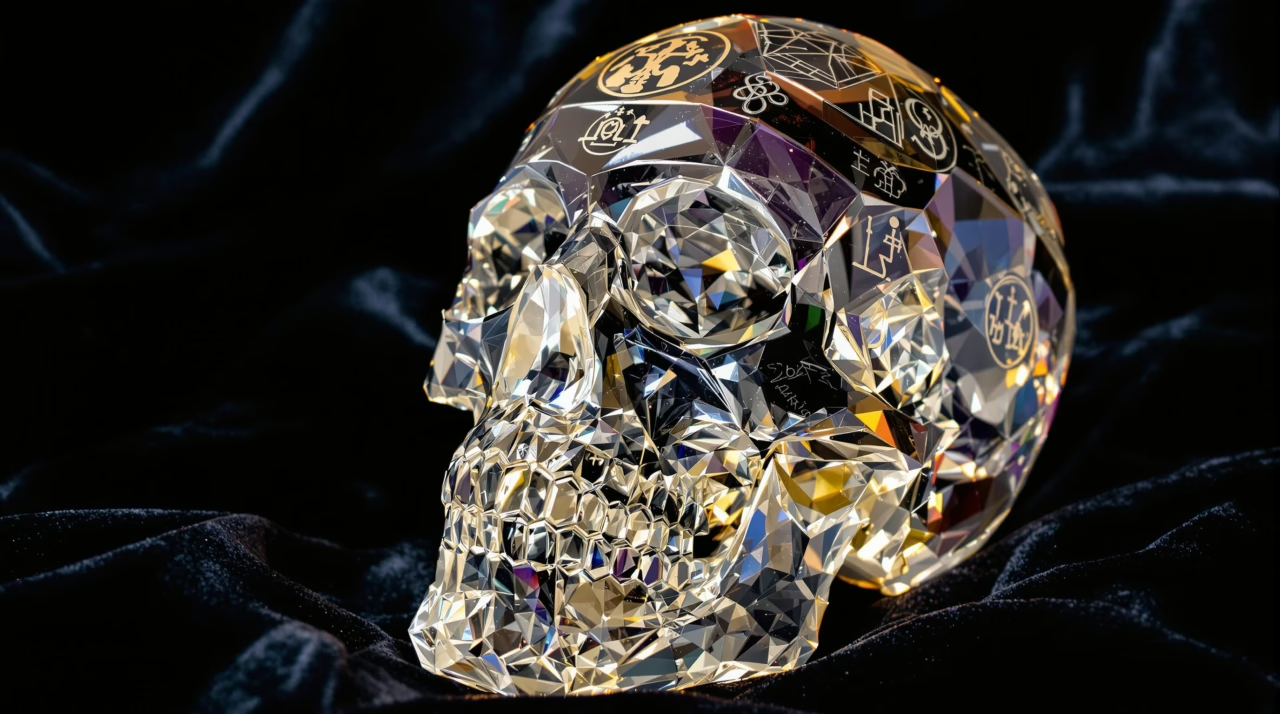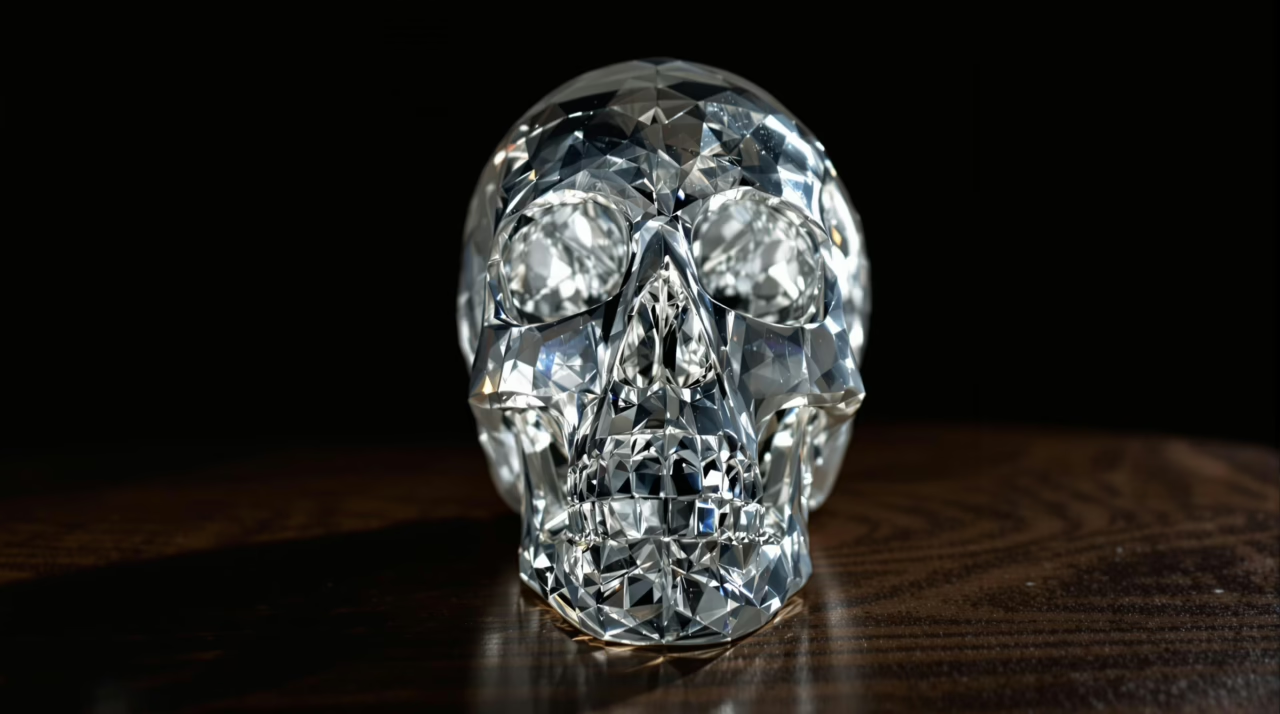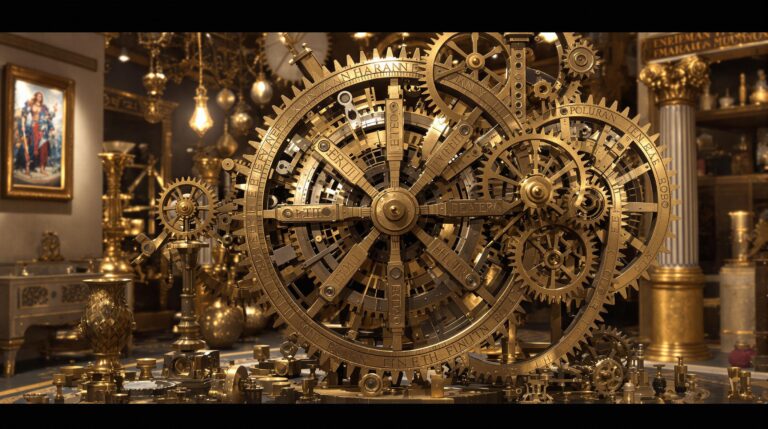Crystal Skulls: Myths, Legends, and the Evidence

Crystal skulls have long captured the imagination, with their enigmatic allure deeply rooted in both myth and popular culture.
While many ascribe mystical properties to these artifacts, scientific scrutiny has revealed modern manufacturing techniques, raising questions about their true origins.
This juxtaposition of belief and evidence invites further exploration into the narratives surrounding these objects. What do these contradictions reveal about humanity’s quest for understanding the past?
Summary & Key Takeaways
Hide- Crystal skulls originated from ancient Mesoamerican cultures, particularly the Maya and Aztec, reflecting spiritual and ceremonial significance.
- European interest in crystal skulls during the 19th century raised authenticity questions, exemplified by the controversial Mitchell-Hedges Skull.
- Modern analyses of crystal skulls reveal tool marks inconsistent with ancient craftsmanship, challenging claims of their origins.
- New Age beliefs attribute healing and transformative properties to crystal skulls, intertwining mythology with contemporary spirituality.
- Ongoing scientific investigations and technological advancements continue to shape discussions about the artifacts' historical context and significance.
The Mysterious Origins of Crystal Skulls

The origins of crystal skulls provoke intrigue, tracing back to ancient Mesoamerican civilizations that ascribed profound significance to these artifacts.
Their subsequent emergence in European collections raises questions about cultural exchange and the artifacts’ true histories.
This intersection of myth and material culture invites a deeper exploration of the narratives that have shaped perceptions of these enigmatic objects.
Tales from Ancient Mesoamerican Civilizations
The origins of crystal skulls can be traced back to the rich cultural tapestry of ancient Mesoamerican civilizations, particularly the Maya and Aztec.
These societies possessed intricate oral traditions and historical records that hint at the significance of such artifacts, suggesting they may have held profound spiritual or ceremonial value.
Exploring these connections raises intriguing questions about the cultural importance of crystal skulls and their role in the mythos of these ancient peoples.
Possible Links to the Maya and Aztec
Legends surrounding crystal skulls often invoke the intricate fabric of ancient Mesoamerican civilizations, particularly the Maya and Aztec.
These cultures, renowned for their advanced craftsmanship and spiritual beliefs, are often credited with the creation of these enigmatic artifacts.
Theories suggest that crystal skulls may have served as ceremonial objects or tools for divination, reflecting profound connections to their cosmology and societal structures.
Significance of Oral Traditions and Records
While the origins of crystal skulls remain shrouded in mystery, the significance of oral traditions and records in ancient Mesoamerican cultures cannot be overstated.
These narratives preserved cultural identities, conveyed spiritual beliefs, and transmitted knowledge across generations. They provide invaluable context for understanding the symbolism attributed to crystal skulls, revealing a colorful mosaic of meaning that continues to captivate modern audiences seeking insight into their enigmatic legacy.
Early Appearances in European Collections
The introduction of crystal skulls to European collections marks a pivotal moment in their storied narrative, as collectors sought to acquire these enigmatic artifacts.
This influx sparked initial debates regarding their authenticity, raising questions about provenance and the motivations behind their acquisition.
Such discussions reveal not only the allure of these objects but also the complex interplay between myth and material culture in the Western imagination.
How Collectors Introduced Skulls to the West
As European collectors began to explore distant lands during the 19th century, they stumbled upon intriguing artifacts that would soon capture the imagination of the Western world.
Among these were crystal skulls, enigmatic objects that seemed to bridge cultures and history. Their introduction ignited curiosity, prompting collectors to acquire and display these relics, fueling myths and legends that would surround them for generations.
Initial Debates on Authenticity
Numerous crystal skulls surfaced in European collections during the late 19th and early 20th centuries, each claiming to possess a unique story and origin.
Initial debates focused on their authenticity, as experts scrutinized craftsmanship and material. The allure of ancient civilizations added mystique, yet many skeptics questioned their provenance, leading to a complex interplay between belief and skepticism that continues to captivate enthusiasts today.
Famous Examples and Their Backstories
The Mitchell-Hedges Skull stands as one of the most enigmatic examples in the lore of crystal skulls, shrouded in tales of supernatural powers and ancient civilizations.
Alongside it, various other renowned skulls housed in museums around the world contribute to the intrigue, each with unique stories that challenge conventional understanding of history and craftsmanship.
Together, these artifacts not only captivate the imagination but also prompt critical examination of their origins and the myths that surround them.
The Mitchell-Hedges Skull
The Mitchell-Hedges Skull stands at the center of a contentious narrative regarding its discovery and subsequent ownership, raising questions about authenticity and provenance.
Conflicting accounts of its origin and dating further complicate the skull’s storied past, making it a focal point for both enthusiasts and skeptics alike.
This ambiguity invites a critical examination of the legends that surround this enigmatic artifact.
Dispute Around Its Discovery and Ownership
As debates surrounding the authenticity of crystal skulls intensify, few cases exemplify the complexity of discovery and ownership more vividly than that of the Mitchell-Hedges Skull.
Allegedly unearthed by F.A. Mitchell-Hedges in 1924, questions arise regarding its rightful ownership and the ethical implications of artifacts taken from indigenous lands, stirring discussions about heritage, responsibility, and the ongoing struggle between personal possession and cultural legacy.
Conflicting Accounts of Origin and Dating
While many enthusiasts celebrate the Mitchell-Hedges Skull as an extraordinary artifact of ancient civilizations, the origins and dating of this crystal skull remain shrouded in controversy.
Claims of its discovery in a Mayan temple in the 1920s clash with skepticism from experts who argue it may be a 19th-century European creation.
Such conflicting accounts highlight the enduring mystery surrounding this enigmatic object and its historical significance.
Other Renowned Skulls in Museums
The British Museum’s crystal skull, shrouded in controversy, has sparked debates over the authenticity of its origins following extensive testing.
Meanwhile, the Smithsonian Institution’s analysis revealed modern tool marks, raising questions about the craftsmanship attributed to ancient civilizations.
These findings challenge the romanticized narratives surrounding these artifacts, inviting a reevaluation of their historical significance.
British Museum Skull and Its Controversial Tests
Among the various artifacts housed in the British Museum, the crystal skull stands out as a focal point of intrigue and controversy.
Initially believed to be an ancient Mesoamerican relic, subsequent analyses revealed inconsistencies in its craftsmanship. Critics argue that modern tools were used in its creation, igniting debates over authenticity.
This case exemplifies the tension between myth and empirical evidence in the domain of archaeology.
Smithsonian’s Conclusion on Modern Tool Marks
Unraveling the mysteries surrounding crystal skulls, the Smithsonian Institution conducted thorough analyses that revealed the presence of modern tool marks on several notable specimens.
This finding challenges the notion of ancient craftsmanship, suggesting instead a more contemporary origin.
Legends and Beliefs Surrounding Crystal Skulls
Crystal skulls have long been imbued with rich spiritual and mystical connotations, often perceived as vessels of ancient wisdom and healing powers.
Their portrayal in Hollywood and popular culture has only amplified these beliefs, transforming them into symbols of adventure and intrigue.
In this way, the legends surrounding these enigmatic artifacts invite a closer examination of the interplay between myth and modern storytelling.
Spiritual and Mystical Connotations
Crystal skulls have long been associated with various spiritual and mystical beliefs, particularly regarding their alleged healing properties and their significance in esoteric practices.
Within New Age movements, these artifacts are often viewed as conduits for energy and knowledge, embodying both ancient wisdom and modern spiritual aspirations.
The allure of crystal skulls lies not only in their physical form but also in the profound narratives that surround their existence and purported powers.
Claimed Healing Properties and Esoteric Practices
Mystique surrounds the legends of crystal skulls, particularly regarding their purported healing properties and esoteric practices. Advocates believe these artifacts possess transformative energies, capable of promoting physical and emotional well-being.
Such claims evoke curiosity about the intersection of ancient wisdom and contemporary spirituality, inviting exploration of the human desire for holistic healing.
Yet, skepticism remains, challenging the validity of these mystical assertions.
Role in New Age Movements
The allure of crystal skulls has found a prominent place within New Age movements, where they are often imbued with spiritual and mystical significance.
Believers assert these artifacts act as conduits for energy, wisdom, and healing. They symbolize a deeper connection to ancient wisdom and consciousness, inviting seekers to explore personal transformation and spiritual awakening, embodying the quest for freedom and enlightenment.
Hollywood and Popular Culture
Crystal skulls have transcended their origins to become iconic symbols within Hollywood and popular culture, often depicted as vessels of ancient wisdom or powerful artifacts.
Films and media representations have not only reinforced existing myths but also expanded their reach to a global audience, sparking curiosity and intrigue.
This cultural phenomenon raises questions about the interplay between myth and modern storytelling, highlighting how legends can evolve in contemporary narratives.
Film and Media Interpretations
Though often shrouded in enigma, the portrayal of crystal skulls in film and media serves to amplify their allure, intertwining historical myths with modern storytelling.
From adventure epics to horror films, these enigmatic artifacts symbolize ancient wisdom and cosmic connections, enchanting audiences’ imaginations.
Such representations not only reflect cultural fascinations but also perpetuate an ongoing dialogue about the unknown and humanity’s quest for understanding.
How Myths Have Spread to Global Audiences
How have ancient legends of crystal skulls captured the imagination of audiences worldwide?
These myths have proliferated through various channels, including:
- Hollywood films, weaving thrilling narratives.
- Documentaries exploring archaeological mysteries.
- Social media platforms, amplifying personal stories.
- International exhibitions, showcasing artifacts.
Such avenues have transformed these legends into global phenomena, inviting diverse interpretations and igniting the quest for truth and freedom in understanding humanity’s past.
Scientific Investigations and Analysis
Scientific investigations into crystal skulls have revealed intriguing details through microscopic examination and the analysis of tool marks, challenging the artifacts’ purported ancient origins.
While enthusiasts and collectors often present counterarguments defending the skulls’ authenticity, the evidence from rigorous analysis raises questions about their true history.
This intersection of science and folklore invites a deeper exploration of the narratives surrounding these enigmatic objects.
Microscopic Examination and Tool Marks
Microscopic examination of crystal skulls has revealed distinctive tool marks that strongly indicate the use of modern grinding techniques, challenging the narrative of their ancient origins.
Laboratory analyses have consistently produced results that contradict claims of these artifacts being crafted by pre-Columbian civilizations. This raises critical questions about authenticity and the implications of contemporary influence on what are often considered historical treasures.
Identifying Modern Grinding Techniques
Recent investigations into crystal skulls have revealed a wealth of information regarding the grinding techniques employed in their creation.
Analysts have identified:
- High-speed rotary tools
- Abrasive materials like diamond dust
- Polishing methods that yield a glass-like finish
- Consistent tool marks indicative of modern craftsmanship
These findings challenge traditional narratives, suggesting a contemporary origin rather than ancient artistry, prompting further exploration into the artifacts’ authenticity.
Lab Results Contradicting Ancient Roots
While many enthusiasts cling to the allure of ancient origins surrounding crystal skulls, lab results have increasingly pointed to a different narrative.
Microscopic examinations reveal modern tool marks inconsistent with ancient craftsmanship, suggesting these artifacts are products of contemporary fabrication.
Such findings challenge long-held beliefs, inviting a re-evaluation of the cultural significance and historical context of these enigmatic objects within the domain of human expression.
Counterarguments from Collectors and Enthusiasts
Collectors and enthusiasts of crystal skulls often assert that these artifacts are remnants of lost civilizations, imbued with mysterious properties that defy conventional explanation.
They argue that certain unexplained phenomena associated with these skulls warrant further investigation, challenging the prevailing skepticism among scientists.
This perspective invites a reevaluation of the narratives surrounding these objects, suggesting that the intersection of belief and artifact may hold deeper truths yet to be uncovered.
Claims of Lost Civilizations
Although the allure of crystal skulls often captivates the imagination, the claims surrounding their origins—particularly those suggesting connections to lost civilizations—invite rigorous scientific scrutiny.
Key points include:
- Lack of archaeological evidence.
- Inconsistencies in dating methods.
- Cultural misappropriation concerns.
- Overreliance on anecdotal accounts.
Such factors challenge the romanticized narratives, prompting a deeper examination of the skulls’ actual provenance and significance.
Supporters Citing Unexplained Phenomena
Despite the skepticism surrounding crystal skulls, supporters often highlight unexplained phenomena that they believe lend credence to the artifacts’ mysterious origins.
Reports of unusual energy fields, spontaneous healing experiences, and inexplicable sound frequencies attributed to these skulls intrigue many.
Such claims challenge conventional understanding, prompting enthusiasts to question established narratives about history and civilization, ultimately advocating for a broader exploration of human potential and consciousness.
Reasons for the Ongoing Debate
The ongoing debate surrounding crystal skulls is fueled by a notable absence of definitive proof regarding their origins and purported powers.
This uncertainty is compounded by society’s enduring fascination with ancient artifacts, which often blur the lines between historical fact and myth.
As enthusiasts and skeptics alike grapple with the implications of these enigmatic objects, the discourse continues to evolve, highlighting the complex interplay between evidence and intrigue.
Lack of Definitive Proof
The ongoing debate surrounding crystal skulls is considerably fueled by the challenges inherent in verifying their historical context.
Gaps in documentation and provenance complicate the narrative, leaving many questions unanswered about their origins and purpose.
This lack of definitive proof invites both skepticism and intrigue, prompting deeper exploration into the myths and legends that surround these enigmatic artifacts.
Challenges in Verifying Historical Context
While many enthusiasts and researchers are captivated by the allure of crystal skulls, the historical context surrounding these artifacts remains shrouded in ambiguity.
Key challenges include:
- Uncertain origins of each skull.
- Inconsistent dating methods employed.
- Discrepancies in cultural attributions.
- The lack of corroborative archaeological evidence.
These factors contribute to the ongoing debate, leaving room for speculation rather than definitive conclusions.
Gaps in Documentation and Provenance
Gaps in documentation and provenance greatly hinder the understanding of crystal skulls, fueling ongoing debates among scholars and enthusiasts alike.
Without definitive historical records or clear origins, the allure of these artifacts remains entwined with speculation and myth.
This uncertainty fosters diverse interpretations, compelling individuals to question the intersection of history, art, and belief, ultimately challenging the quest for knowledge and authenticity.
Enduring Fascination with Ancient Artifacts
The allure of ancient artifacts like crystal skulls can be traced to humanity’s intrinsic attraction to mystery and the unknown.
This fascination is fueled by the tantalizing possibility that future discoveries may reveal secrets long buried in time.
As debates continue over their origins and significance, these enigmatic objects remain a potent symbol of our quest for understanding.
The Human Attraction to Mysteries
Mysteries have an intrinsic allure that captivates the human psyche, particularly when intertwined with ancient artifacts like crystal skulls.
This fascination can be attributed to:
- The quest for knowledge and understanding.
- The romanticism of the unknown.
- The potential for reinterpreting history.
- The emotional connection to human experiences across time.
Such elements fuel ongoing debates surrounding these enigmatic objects.
Possibility of Future Revelations
How do ancient artifacts like crystal skulls continue to inspire debates and speculation about their origins and significance?
The allure of these enigmatic objects fuels ongoing inquiry, as enthusiasts seek both scientific validation and mystical interpretations.
This duality invites diverse perspectives, ensuring that discussions surrounding crystal skulls will evolve.
As technology advances, future revelations may further challenge or reinforce existing narratives, enthralling the curious mind.
Wrapping Up
To summarize, while skeptics may argue that the modern tool marks on crystal skulls diminish their allure, this perspective overlooks the deeper significance of these artifacts.
They serve as a cultural touchstone, reflecting humanity’s enduring quest for meaning and connection to the past.
The interplay of myth and reality invites not only skepticism but also wonder, encouraging a broader exploration of the narratives we construct around the unknown, thereby enriching our understanding of both history and ourselves.
